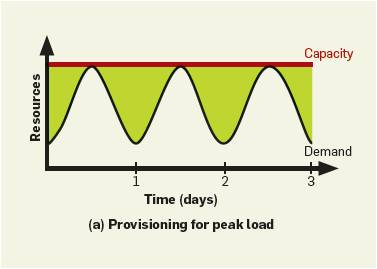In this article we will learn about cloud computing economics. This presents three use cases of utility computing where conventional computing is used and how cloud computing’s elasticity feature can overcome the limitations of conventional computing.
There are three particularly compelling use cases for utility computing over conventional computing [1]:
- When the demand varies over time. For example in conventional computing the organization has to invest (to meet demand) in capital expenditure prior to starting its operations and there is no guarantee that demand will always be below the expected margin. Utility computing (cloud) can scale the resources as per demand and the customer pays for only what they use.
- When demand is unknown in advance. For example a web start up will need to support a spike in demand when it becomes popular, followed by a reduction in demand later.
- Organizations that perform batch jobs can use “cost associativity” of cloud computing to finish computations faster. For example using 1000 machines for one hour or using 1 machine for 1000 hrs is the same in utility computing (cloud).
We now look at various examples where cloud elasticity is really useful. First, we consider a case where an organization does over provisioning of resources. This scenario is depicted as shown below:
Image source: Reference [1]
The red line indicates the resources available for which the organization has already paid and the wave like line (demand curve) represents the actual resources being used. You can see that over a period of time, majority of the resources are not being used (shaded area in the above figure). This leads to under utilization of the resources.
Second, we consider a case where the organization has underestimated the demand. This is an example of under provisioning (saturation). This scenario is depicted as shown below:
Image source: Reference [1]
You can see from the above figure that the capacity (resources) is not able to serve the demand. This may lead to unsatisfied users (shaded area in the above figure) and a permanent loss of potential revenue. As a real world example for this case consider Friendster (a social networking site). The demise of this site is considered to be slow response (up to 40 sec).
Third, we consider a situation where the demand is uneven as shown below:
Image source: Reference [1]
In this scenario, the organization looses potential users that may add to the revenue stream. The business functional normally again when the demand equals the capacity (resources). As an example for this scenario consider Animoto (a video making and photo slide-show making website) which found a spike in demand when they a released a Facebook plugin. The demand almost doubled per 12 hours for 3 days. After that demand again subsided.
For all the above three scenarios cloud computing’s elasticity is the best solution as the resources scale up and down based on demand.
References
[1] M. Armbrust, I. Stoica, M. Zaharia, A. Fox, R. Griffith, A. D. Joseph, R. Katz, A. Konwinski, G. Lee, D. Patterson, and A. Rabkin, “A view of cloud computing,” Commun. ACM, vol. 53, no. 4, pp. 50–58, 2010.
Suryateja Pericherla, at present is a Research Scholar (full-time Ph.D.) in the Dept. of Computer Science & Systems Engineering at Andhra University, Visakhapatnam. Previously worked as an Associate Professor in the Dept. of CSE at Vishnu Institute of Technology, India.
He has 11+ years of teaching experience and is an individual researcher whose research interests are Cloud Computing, Internet of Things, Computer Security, Network Security and Blockchain.
He is a member of professional societies like IEEE, ACM, CSI and ISCA. He published several research papers which are indexed by SCIE, WoS, Scopus, Springer and others.






Leave a Reply